Danzig Highflyer Pigeon: Breed Guide
The Danzig Highflyer Pigeon is a versatile breed that excels in both show and flying purposes. It has a captivating appearance, featuring a crest over its head, a variety of colors, and a fan-shaped tail.
These birds can also fly incredibly well, reaching tremendous heights and doing amazing aerial feats. This breed, which has its roots in Poland from the early 1800s, is the product of years of careful selective breeding.
In this article, we will provide you with all the information you need to know about this breed. Its background and origins, physical attributes, behavior and qualities, upkeep and breeding, pet appropriateness, care advice, and more will all be covered.
Danzig Highflyer Pigeon Profile
| Name | Features |
|---|---|
| Scientific Name | Columba livia |
| Common Names | Danzig Highflyer Pigeon, Columba livia, high-flying pigeon. |
| Origin | Poland, vicinity of Danzig (presently Gdańsk) |
| Size | Medium-sized |
| Weight | 2½ lbs |
| Lifespan | Around 10+ years |
| Physical Features | Crest on head, white eyes, small beak, short tail, and broad chest and wings. |
| Temperament | Gentle and calm |
| Behavior | Always on alert, highly active. |
| Special Features | Crest across head, short fan-shaped tail, strong flyers, and come in various colors. |
| Breeding and Maintenance | Feeds on seeds, grains, and occasional greens. Requires selective breeding, nesting spots, health monitoring, and comfort. |
| Common or Popular Varieties | The two major varieties are for show/exhibition and for flying or as pets. |
Interested in similar topics on pigeon breed:
Overview Of Danzig Highflyer Pigeon
The Danzig Highflyer pigeon came into existence through selective breeding. It is a breed of fancy pigeons which originates from Poland.
These pigeons come in two major varieties: exhibition breeds (used for shows and flying competitions) and pet breeds (domestic and well-behaved).
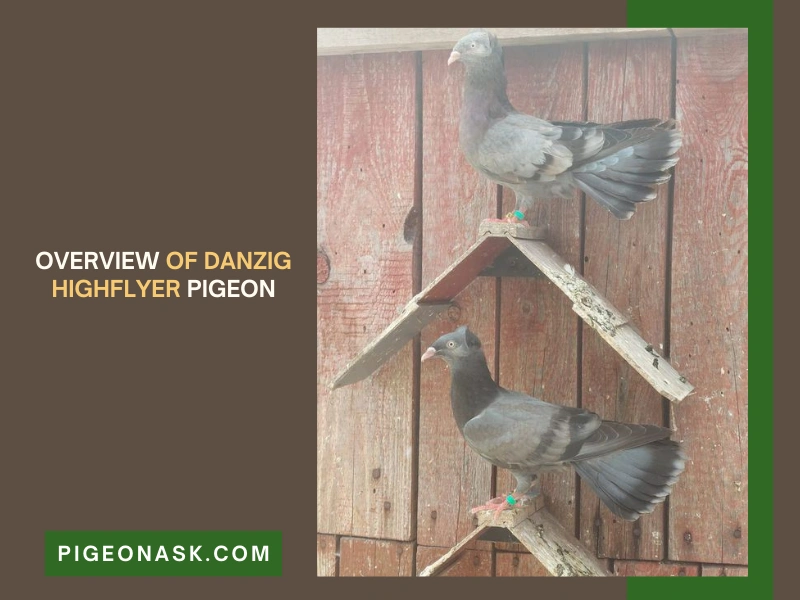
When considering their appearance, these pigeons are average-sized with distinct features. Among their bold features, the most noticeable is the crest on their heads.
They also have round, pearly-white eyes, a medium-length beak, and a short fan-shaped tail.
In terms of behavior, Danzig Highflyers are known for their activity and alertness. They are able to cohabit with other pigeons and have incredible flying abilities.
During flight, they spread their wings and tails to soar high. This also gives them the ability to maintain stability in high altitudes.
Since they come from selective and planned breeding, they also require a monitored environment when breeding. Proper nutrition, selective pairing, and a secure nest are their bare necessities.
To upkeep their maintenance, they need a good circulation of grains, seeds, and occasional greens in their diet. They also require lots of attention and space for themselves.
History And Origin
After many years of selective breeding, the Danzig Highflyer pigeon came into existence. It has roots in the vicinity of Danzig (now Gdańsk) in Poland around the 19th century, hence its name.
These pigeons, along with their domesticated varieties, descend from the rock pigeon, or Columba livia. Over time, the Danzig Highflyer pigeon split into two major variations: one for exhibition and the other as pets.
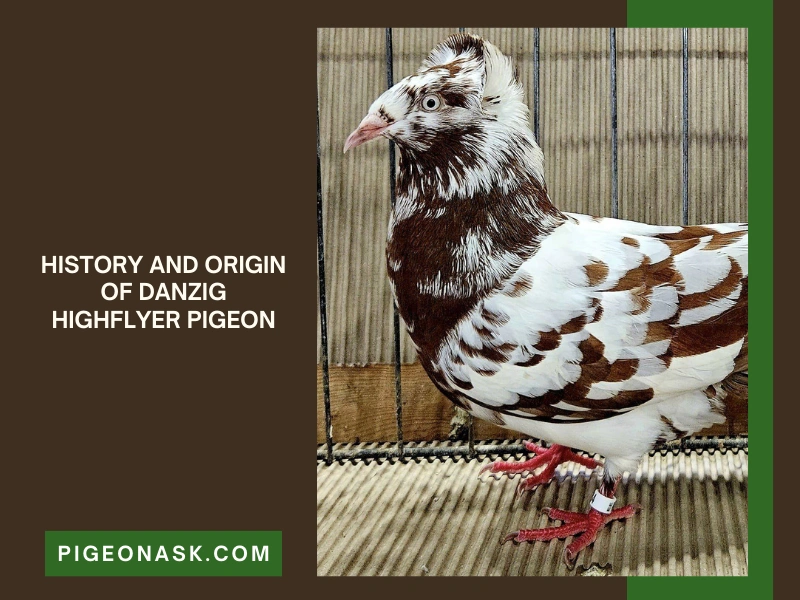
This breed first began when a cross-breed of Persian doves and pigeons emerged in southern Poland. It has also been reported that pigeons from Calcutta in India have also contributed to the development of this new breed.
These pigeons are the epitome of the skill of selective breeding—they are elegant and sensible all at once. Bird enthusiasts all around the globe are fascinated with Danzig Highflyers, whether they are shown in exhibitions or let free to soar.
Physical Characteristics And Features
Unlike other pigeon breeds, the Danzig Highflyer is known for its striking features and overall physical appearance. It is arguably one of the most visually stunning birds and is a common favorite among bird enthusiasts.
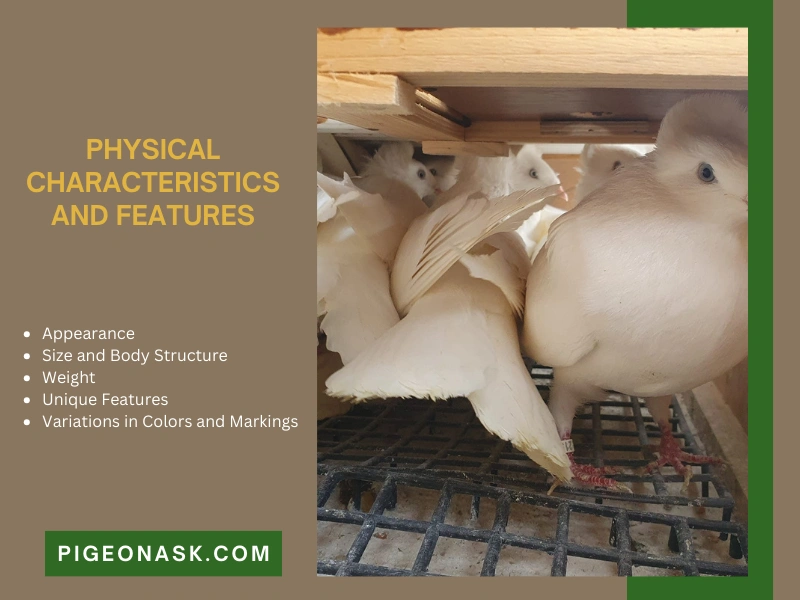
These factors are what make this pigeon stand out among the rest –
Appearance
All in all, the Danzig Highflyer is a captivating pigeon with overall gorgeous features. However, its most distinct feature is the beautiful crest that crowns its head. This crest commonly goes across the head from ear to ear and accentuates the pigeon’s eyes and beak.
To add to its graceful appearance, the pigeon has pearly-white eyes and a medium-length beak.
Size and Body Structure
These pigeons are not too big nor too petite. Their bodies are average-sized and well-proportioned, with a broad chest and a strong set of wings.
Because of their size and well-balanced structure, their weight is evenly distributed, which allows them to soar through the sky. They are also able to perform tricks while in flight due to their body structure.
Weight
Although exact weight ranges may differ, Danzig Highflyers typically keep an adequate weight. They can effortlessly do aerial acrobatics, demonstrating their power and agility because of their lightweight build.
Unique Features
Apart from their crest, their most unique feature is their fan-shaped tails. When the Danzig Highflyer springs into flight, the feathers of their tail spread out into a fan. This not only creates a mesmerizing display but helps them to achieve balance.
A unique trait like this sets them apart from other pigeon breeds and adds to their allure.
Variations in Colors and Markings
Danzig Highflyers come in a diverse range of colors and markings. Commonly, they are found to be in shades of white, red, blue, silver, and other neutral tones.
Some of them even have intricate patterns on their feathers, which make them more unique and rarer.
Distribution And Habitat
Pigeons are considered pests in almost all parts of the world, and Danzig Highflyers aren’t exempt from this view. Due to their ancestry, they are able to adapt to almost any environment. But they still have requirements for a suitable habitat.
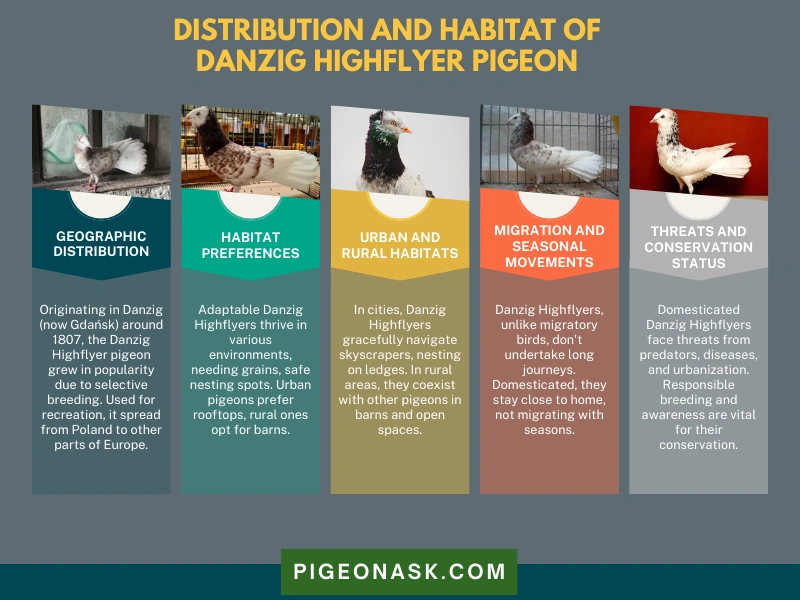
Geographic Distribution
The Danzig Highflyer pigeon, in its first form, initially appeared in Poland in the area of Danzig, which is now known as Gdańsk around 1807. Its population became greater after it was selectively bred for years and sought after by bird enthusiasts.
Soon enough, this pigeon was being used for mainly recreational purposes, such as entertainment and keeping as pets. As a result, they moved from Poland to other parts of Europe.
Habitat Preferences
Danzig Highflyers are able to adapt to almost any environment, ranging from urban to rural.
All they need is a stable environment with grains and seeds and safe spots for nesting. Non-domesticated kinds usually prefer to build their nests on rooftops in urban areas and countryside barns in rural areas.
Urban and Rural Habitats
These pigeons are commonly seen in urban settings, effortlessly gliding around cityscapes and nesting on tall buildings’ ledges or windowsills.
Against the backdrop of skyscrapers, their ability to soar and do aerial gymnastics makes them an alluring sight. They live side by side with other pigeons in barns, fields, and open areas in rural areas.
Migration and Seasonal Movements
Unlike migratory birds, Danzig Highflyers do not exhibit long-distance migrations. They are primarily domesticated and do not have significant seasonal movements.
Danzig Highflyers do not migrate across great distances, in contrast to other migratory birds that travel great distances. They are mostly farmed birds, not designed for transcontinental trips but rather for their special flying skills.
Plus, these birds don’t really travel with the seasons because they spend the entire year near their home lofts.
Threats and Conservation Status
As a domesticated breed, their conservation status is not currently at threat. However, like all pigeons, their population can be affected due to predators, diseases, and habitat changes.
Although they are able to adapt to urban settings, the increased rates of urbanization are harmful to them, especially the kinds that live in rural areas.
Responsible breeding practices and awareness of their unique qualities can help reverse the possibility of population decline.
Behavior And Traits
Although they are bred from common pigeon types, the Danzig Highflyer has specific behavioral traits that make them unique among other pigeons. For one, their calm and gentle demeanor is remarkable and unlike other birds.
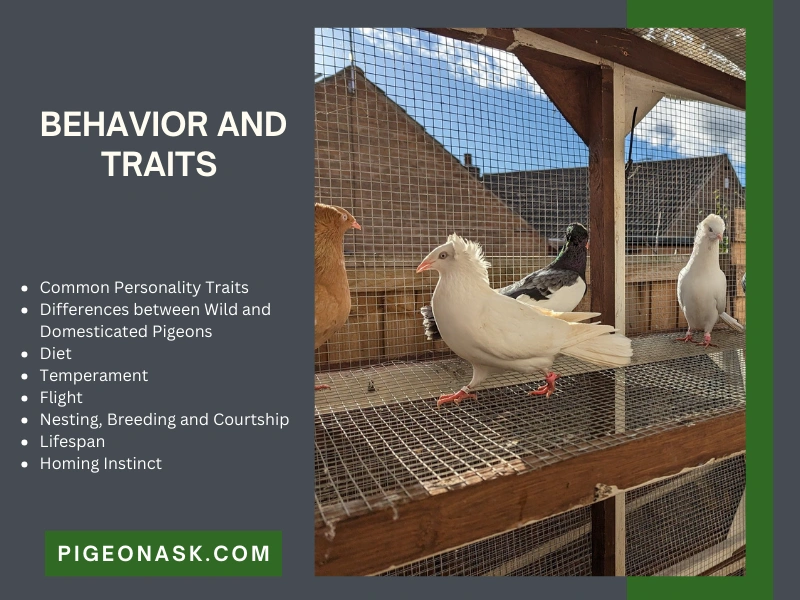
These are other outstanding traits of the Danzig Highflyer –
Common Personality Traits
The common personality traits among Danzig Highflyer pigeons are alertness, activity, and strong constitution.
They are curious birds with an affinity for adventure. These pigeons love to explore their surroundings and different environments. Their inquisitive nature makes them fun pets to keep around.
Differences between Wild and Domesticated Pigeons
Domesticated Danzig Highflyers have gone through years of selective breeding, which wild ones have not. Due to being raised in different environments, they each have specific traits for their intended purposes.
For example, domesticated pigeons are more visually attractive and vibrantly colored than wild pigeons. They are also more comfortable around humans and less wary of disturbances.
Diet
Danzig Highflyers eat mostly grains and seeds, with some green vegetables occasionally, as part of a simple diet. Their general health and vigor are ensured by feeding them a balanced diet. They are easy to take care of because their food requirements are not very complicated.
Temperament
These pigeons have a generally gentle temperament. They are not aggressive and can coexist peacefully with other pigeons in shared spaces.
Their calm demeanor makes them suitable for both show purposes (where they need to be handled) and as pets (where they interact with family members).
Flight
Danzig Highflyers are known for their excellent flying capability, hence their name. They are able to reach impressive heights and soar in high altitudes without struggle.
These highflyers are also one of the rare bird types that are able to perform tricks while in flight, which is why they are often used for bird shows.
Nesting, Breeding and Courtship
For nesting, Danzig Highflyers prefer quiet and safe spots such as nooks in lofts or cozy corners to lay and watch over their eggs. Their courtship involves head-bobbing, gentle cooing, and mutual preening.
Once these pigeons are paired, they quickly begin to build a simple nest using twigs and soft materials around the area.
Lifespan
With proper care, these pigeons can live for several years. Their lifespan typically ranges from 5 to 10 years, depending on factors such as diet, health, and environment.
Homing Instinct
Danzig Highflyers have an excellent locating instinct, much like many other pigeons. Their ability to figure out how to go home if released far from their home has been used for generations in pigeon racing.
Breeding And Maintenance
Danzig Highflyers are normally easier to breed than other birds, as they do not hold many strict requirements. Given the basic necessities, you can easily breed these pigeons and produce healthy offspring.
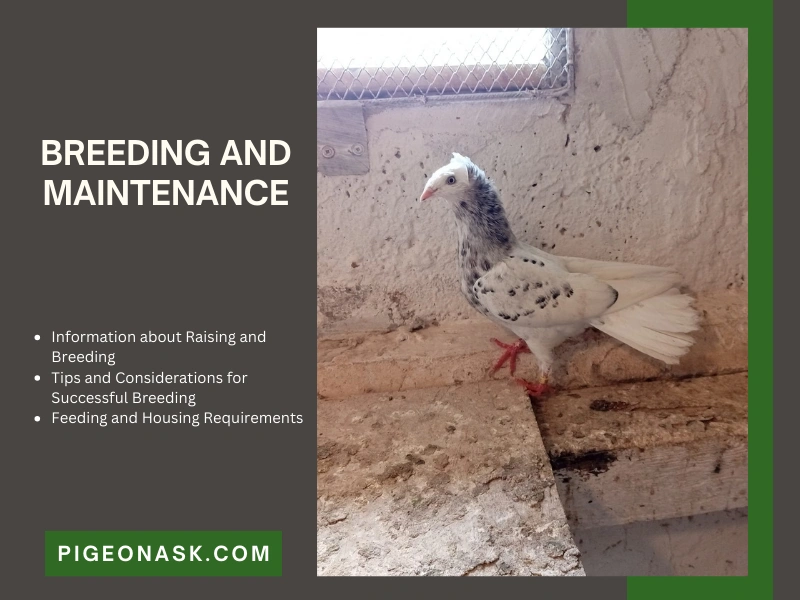
However, there is some vital information you need to keep in mind to ensure successful breeding –
Information about Raising and Breeding
For Danzig Highflyer Pigeons, breeding is very important, and they put a lot of effort into nesting and laying eggs.
Choose the pairing wisely if you want the baby pigeons to have the qualities you desire. Consider the age, genetics, and state of health of the pigeons.
Every pigeon pairing needs a separate spot for nesting, and the nest needs to be comfortable enough for the babies.
The mother lays two eggs, which are then alternately warmed by each parent until they hatch. After that, they look after the babies until they are able to feed themselves.
Tips and Considerations for Successful Breeding
When breeding Danzig Highflyers, consider the following –
- Selective Pairing: Choose breeding pairs carefully. Match birds with desirable traits, such as strong flying abilities or beautiful crests.
- Secure Nesting Spots: Provide secure nesting spots, such as cozy corners or nooks in lofts, where they can lay eggs.
- Nutritious Diet: Ensure a balanced diet of grains, seeds, and greens. Proper nutrition supports healthy babies.
- Health Monitoring: Regularly check for signs of illness or parasites. Prompt veterinary care is essential.
- Comfortable Housing: Maintain clean and spacious lofts with proper ventilation. Cozy and quiet surroundings promote successful breeding.
Feeding and Housing Requirements
Danzig Highflyers thrive on a balanced diet of grains, seeds, pigeon feed, and clean water. A healthy diet is essential to their wellbeing and successful breeding.
These pigeons require a safe, roomy, and well-ventilated loft or aviary for nesting and laying eggs. They should be kept away from predators and harsh weather and given vet care whenever required.
Breed pairings should have access to nesting boxes and their surroundings should be clean to avoid health problems. Within their enclosure, these pigeons also prefer perches and lots of room for exercise and flying.
Conclusion
In conclusion, the Danzig Highflyer pigeon is a stunning and graceful breed that stands out for its unique features and gentle personality.
They have amazing flying skills and diverse colors and patterns, which make them popular among pigeon lovers.
To ensure their health and happiness, these birds need a balanced diet, comfortable housing, and attentive care. Whether you’re a seasoned breeder or a pigeon admirer, the Danzig Highflyer is a wonderful addition to any aviary or loft.
